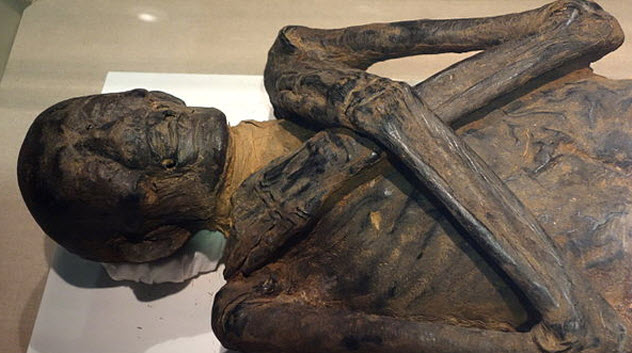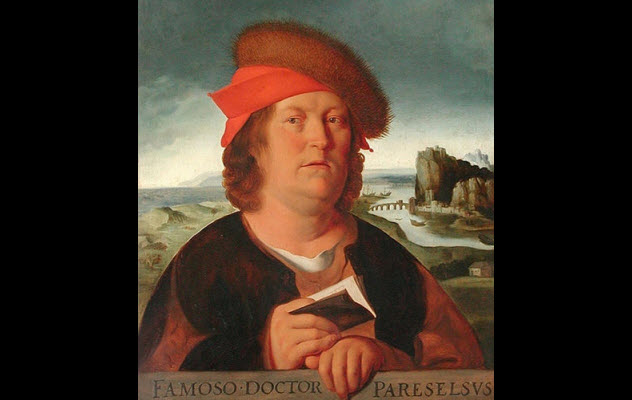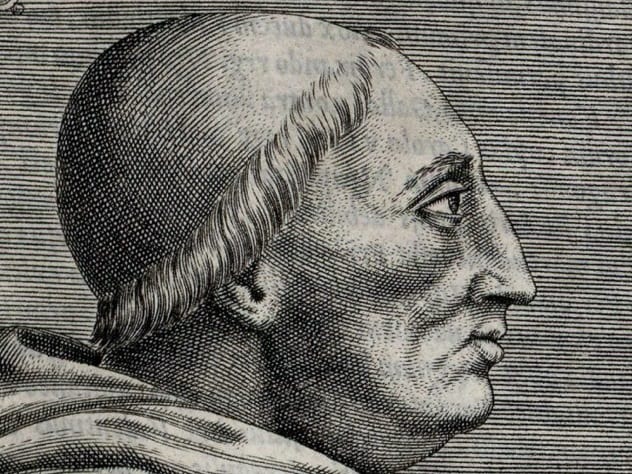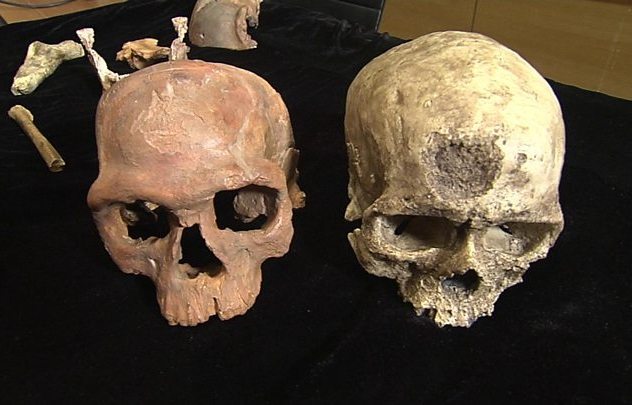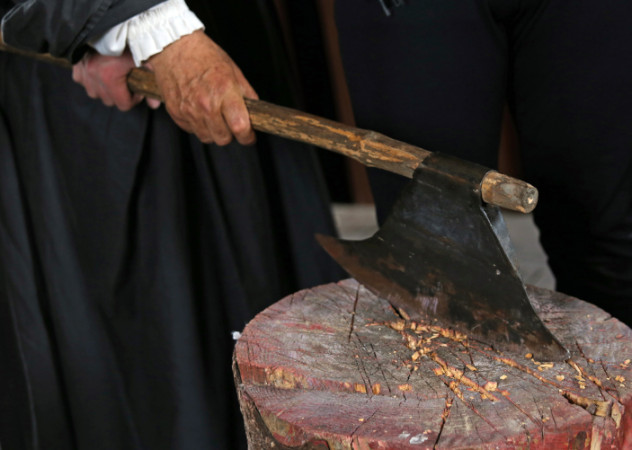10 Bizarre Things People Did With Corpses
10 Yummy Mummies for Medicine
In the Middle Ages, physicians began to use the bodies of ancient Egyptian mummies for medicine. In 1424, for example, the authorities in Cairo discovered persons who confessed under torture that they ‘were removing bodies from the tombs, boiling them in hot water, and collecting the oil which rose to the surface. This was sold to the Europeans for 25 gold pieces per hundredweight. The men were imprisoned’. By the time of Shakespeare, in the 1580s, one Elizabethan traveller told of seeing ‘the bodies of ancient men, not rotten but all whole’, being daily unearthed from a Cairo pyramid. And a British merchant apprentice, John Sanderson, illicitly obtained a mummy shipment of over six hundred pounds in weight. Come the late 17th century, it was getting much harder to smuggle mummies into Europe for medicine. Accordingly, merchants in Egypt baked up the flesh of dead lepers, beggars or camels into ‘counterfeit mummy’ to satisfy European demand. Finally, the trade plundered ‘Guanche mummies’ from the Canary Islands. As the Guanche people were thought to have emigrated from North Africa, the civilised Europeans were in fact eating Africans; and also eating ancient Egyptians, founders of perhaps the greatest civilization the world has ever known. Perhaps the Europeans were the Real Savages after all.
9 Drink the Red Tincture
Well: you may first want to know how it was made. One should take ‘the cadaver of a reddish man … whole, fresh without blemish, of around twenty-four years of age, dead of a violent death (not of illness), exposed to the moon’s rays for one day and night, but with a clear sky’. One must next ‘cut the muscular flesh of this man and sprinkle it with powder of myrrh and at least a little bit of aloe, then soak it, making it tender, finally hanging the pieces in a very dry and shady place until they dry out’. Finally, ‘a most red tincture’ could be extracted from this artfully cured flesh. This kind of recipe was popular among followers of the controversial medical reformer Paracelsus (d.1541). And many of these followers were extremely influential. The Paracelsian Sir Theodore Turquet de Mayerne (1573-1655) has rightly been dubbed ‘Europe’s physician’. In his long career he treated Henri IV, Elizabeth’s Secretary of State, Robert Cecil, James I, John Donne, Charles I, Charles II, and Oliver Cromwell.
8 The Vampire Pope and the Vampire Aristocracy
In July 1492 Pope Innocent VIII lay dying. One of the alleged cures attempted at Innocent’s deathbed is particularly memorable. Three healthy youths were bribed by the pope’s physician, with the promise of a ducat apiece. The youths were then cut and bled. All three presently bled to death. The pope drank their blood, still fresh and hot, in an attempt to revive his failing powers. The attempt was not successful. Innocent himself also died soon after, on 25 July. So runs the account of the pope’s contemporary, Stefano Infessura. Infessura was a lawyer and a fierce critic of Innocent VIII. Can his claims be trusted? Contemporary evidence shows that Innocent’s Vampire Cure seems to have been merely a more extreme version of a therapy recommended by others. Marsilio Ficino (1433-1499), for example, was one of the most highly-respected figures of Renaissance Europe. And he too believed that the aged could rejuvenate themselves if they would ‘suck the blood of an adolescent’ who was ‘clean, happy, temperate, and whose blood is excellent but perhaps a little excessive’. In 1777 one Thomas Mortimer claimed that, ‘towards the close of the fifteenth century, an idle opinion prevailed, that the declining strength and vigour of old people might be repaired by transfusing the blood of young persons’. He adds that some ‘drank the warm blood of young persons’ and that the practice was suppressed in France after ‘some of the principal nobility … turned raving mad’ as a result.
7 Cannibal monarchs
Here’s something you were never taught in your school history classes. James I refused corpse medicine; Charles II made his own corpse medicine; and Charles I was made into corpse medicine. James was in fact unusual in his refusal, and it was somewhat surprising, as he was one of the most disgusting monarchs in British history. He never washed or changed his clothes, and was so fond of hunting that he would urinate in the saddle to save the trouble of dismounting. As for Charles I? His blood was mopped up with handkerchieves by spectators after his beheading in 1649. There is in fact a painting of this, by an eyewitness, John Weesop. Intriguingly, some of the handkerchieves belonged to Parliamentarians, who still nonetheless believed that the king’s blood could cure ‘the king’s evil’. But the biggest player of all in the dark world of corpse medicine was Charles II. Charles reportedly paid £6,000 for the recipe for ‘spirit of skull’, originally formulated by the eminent chemist Robert Goddard in the 1650s. This distillation now became so closely associated with Charles that it was known as ‘the King’s Drops’, and was in great demand amongst élite patients. One Lady Anne Dormer drank them with chocolate against depression, and they were given to Queen Mary on her deathbed in 1694. Before that, they were the very first remedy Charles reached for on 2 February 1685, a few days before he died. In France decades before, the Emperor Francis I (d.1547) ‘always carried [mummy] in his purse, fearing no accident, if he had but a little of that by him’. In Britain William III was given powdered skull for his epilepsy.
6 Cannibal Aristocrats and Gentry
Robert Boyle, the aristocrat who became known as the Father of Chemistry, distilled human blood into various treatments around this time, and would sometimes give these to a noble or genteel patient under a false name, lest they had qualms about swallowing blood. He claimed a near miraculous recovery in one case. Whilst some of the nobility were therefore unwitting vampires, others were quite openly cannibalistic. A 1653 cure for epilepsy included ‘a pennyweight of the powder of gold, six pennyweight of pearl, six pennyweight of amber, six pennyweight of coral, and eight grains of bezoar’, adding: ‘also you must put some powder of a dead man’s skull’. This came from the recipe book of Elizabeth Grey, Countess of Kent. Historian Elaine Leong has shown that many other noblewomen and gentlewomen of the age made their own cannibal medicines, using mummy, skull, or blood and fat. If you were a humble tenant of such a woman, you would probably not have the nerve to refuse the cannibal treats she offered you. 10 Secrets Of Ancient Medicine
5 The Secret History of Human Skulls
If you happened to chance upon a human skull in the time of Charles II, you would probably feel great joy, rather than great fear. A prized medical commodity, one single skull could be worth as much eleven shillings (whilst an unskilled labourer might earn perhaps ten pence a day). Shavings or powder of skull could be used against epilepsy and haemorrhoids, and the King’s Drops against everything from depression down to miracle cures on the deathbed. The most highly valued skull was one with moss on it, as pictured on the cover of Mummies, Cannibals and Vampires. This moss would be powdered and then used to stop bleeding: either on wounds or thrust up the nostrils against nosebleeds. Robert Boyle himself used it against a severe nosebleed one summer, and swore that it worked, even when merely held in his hand. Boyle’s family were from Ireland, and so was the moss which he used. With no one left to bury the dead after the war crimes of English invaders, skeletons and skulls lay in green Irish fields for perhaps decades, and in some cases botanical moss grew on the skull. You could see these in London chemists’ shops around 1750, in the time of Dr Johnson. As late as the 1770s, by the time Mad King George III was on the throne, there were still import and export duties on skulls brought from Ireland, and later shipped onto Germany.
4 The Secret History of Human Fat
In October 1601, the then Dutch city of Ostend was a few weeks into the longest siege in history. At one point, the Dutch lured a party of Spanish besiegers into a trap and slew them all. After rifling the corpses for valuables and arms, a few of the Dutch could also be seen dragging wobbling sacks back into the city. They contained human fat, swiftly plundered from the fresh corpses by surgeons. The reason for this was that human fat was a prime treatment against wounds and sores. Usually, the chief source of fat at this time was the executioner. In France, Italy and northern Europe he would either sell it to chemists or treat you himself. Executioners performed a surprising number of cures in this era, and in Germany one of them (records Kathy Stuart) was supposed to have saved a limb given up for amputation. The bandages he used were almost certainly soaked in human fat. In Britain in the time of Dr Johnson, fat continued in use as other corpse medicine was attacked. It was used to treat rabies, gout, cancer and arthritis. Some idea of its value comes from an incident in Norfolk in 1736. After a man and his wife had ‘had some words’, the husband suddenly ‘went out and hanged himself’. An inquest ruled that, as this was suicide, the man must be buried at the crossroads. But, eschewing funeral or burial, ‘his wife sent for a surgeon, and sold the body for half a guinea’. While the surgeon was carefully ‘feeling about the body’ the woman assured him: ‘”he is fit for your purpose, he is as fat as butter”‘.
3 Medical Vampires at Public Executions
Touring Vienna in the winter of 1668-9, the English traveller Edward Browne saw a public execution, the man beheaded whilst sitting in a chair. ‘As soon as his head fell to the ground, a man ran ‘speedily with a pot in his hand, and filling it with the blood, yet spouting out of his neck, he presently drank it off, and ran away’. This he did, Browne adds, ‘as a remedy against the falling-sickness’. By this time, hundreds if not thousands of those suffering ‘the falling-sickness’ (as epilepsy was then known) had drunk hot fresh blood at public executions in Austria, Germany and Scandinavia. And hundreds or thousands more would continue to do so until at least 1866. In Denmark in 1823 the Danish storyteller Hans Christian Andersen saw ‘”a pitiful poor person made to drink by his superstitious parents a cup of the blood of an executed person, in an attempt to cure him from epilepsy”’. In Sweden the authorities did not permit blood drinking at beheadings. At a beheading in 1866 soldiers were stationed to prevent the rush for blood, so that it soaked into the earth. But as soon as the guards had left, people surged forward and, falling to their knees, crammed the bloodsoaked dirt into their mouths.
2 The Secret History of the Soul
A great many forms of corpse medicine were underpinned by one extraordinary belief: simply, that you could swallow the powers of the human soul by drinking blood, or various distillations of skull or flesh. In this sense, then, the Whitewashed Cannibalism of Europe was emphatically Christian. Those who drank hot blood at executions might seem to have the highest chance of absorbing such power. In most cases the felon was not obviously dead as they drank. As epilepsy was then held to be a disease of the soul, there was also a special logic linking disease and cure. In other cases, the bodies of criminals used by chemists may have hung on gibbets for some time. But our medical reformer Paracelsus, champion of such recipes, had stated quite precisely that such a corpse was useful for up to three days. This claim was rooted in a startling but widespread belief of northern Europe. For some time after what we might call legal death, the power of the soul was held to smoulder on in the body. It was associated with the blood in particular, but also with very fine hot spirits of blood which saturated all flesh and bone. Because the soul and spirits were a physical force at this time, the young red-headed man killed by violence offered the greatest source of youthful vitality, as well as the best type of flesh and blood.
1 When and why did it end?
The educated began to turn against corpse medicine around 1750. Dr Johnson and his new Dictionary were key players in this shift, with Johnson deriding the ‘horrid medicines’ of a backward past. Johnson and others sought to create a new culture of Reason opposed to unenlightened Superstition. They also increasingly gave up the idea of the soul in the body, which meant that people no longer seemed worth eating for medicine. And as the emerging Medical Profession struggled to clean up its Public Image, corpse medicine seemed an increasingly hard sell to genteel patients, who were now more easily disgusted than those of the Restoration. But corpse medicine continued amongst ordinary people for well over a hundred years. Along with the vampires of continental beheadings, we hear of Britons obtaining skulls to treat their children in Victorian times; whilst in Scotland until around 1900 epileptics might be advised to drink from the skull of a suicide. No less strange for being true. 10 People Who Lived With Dead Relatives About The Author: Richard Sugg is the author of eleven books, including Mummies, Cannibals and Vampires: The History of Corpse Medicine from the Middle Ages to the Falun Gong; Fairies: A Dangerous History; Our Week with the Juffle Hunters; and The Smoke of the Soul. He has previously lectured in English and History at the universities of Cardiff and Durham (2001-2017), and his work has featured in The Guardian, Der Spiegel, The Lancet, The Times, Daily Telegraph, the London Review of Books and The New Yorker, among others. Mummies, Cannibals and Vampires has been translated into Turkish. He has appeared on television with Pat Spain, and with Tony Robinson, when they made cannibal medicines for Channel 4. It was educational. @DrSugg
